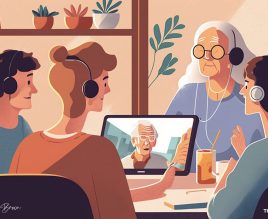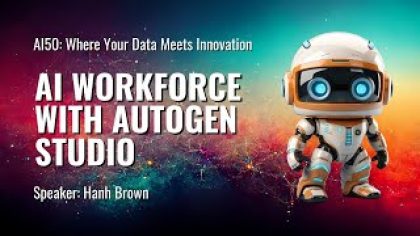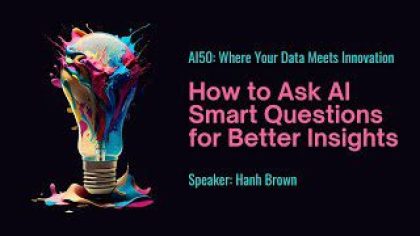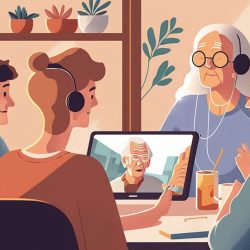Table of Contents
ToggleOnce a far-off dream of science fiction, artificial intelligence (AI) has emerged as an everyday reality, revolutionizing our lives. This technology, while commonly associated with the youth, has been quietly transforming the lives of older adults, aiding them in aging gracefully. AI promises vast benefits for seniors, spanning healthcare, daily living, and even social connection, altering the narrative of aging.
However, this novel prospect doesn’t come without challenges. As we delve into the world where older adults coexist with AI, we ought to address the potential obstacles, primarily, their digital literacy and privacy concerns. Thus, the onus lies on us, the society, to ensure a seamless and respectful integration of AI into older adults’ lives.
AI in Healthcare for Older Adults
Healthcare represents a primary domain where AI is significantly enhancing older adults’ lives. By infusing AI into healthcare services, we’re witnessing an innovative evolution in patient care that prioritizes personalized, accessible, and efficient services.

This transformation is particularly advantageous for older adults, who often require regular health monitoring and assistance. In this journey towards optimal healthcare, AI presents several notable advancements, including telemedicine and remote monitoring.
Telemedicine and Remote Monitoring
At the forefront of AI’s healthcare revolution lies telemedicine and remote monitoring. This advancement has addressed a major concern for older adults – the need for frequent medical visits. With AI-powered telemedicine, seniors can consult their physicians remotely, eliminating geographical barriers.
Moreover, AI-driven remote monitoring allows real-time health tracking, alerting healthcare providers about any discrepancies, ensuring prompt response. Consequently, telemedicine and remote monitoring foster independent living, with a safety net firmly in place.
1. Benefits of Remote Healthcare
The rise of remote healthcare through AI is not merely a technological marvel; it’s a lifeline that promises substantial benefits for older adults. Firstly, it encourages independence. Older adults can manage their health from the comfort of home, diminishing the dependency on others. This factor could significantly enhance their self-esteem and quality of life.
Secondly, AI-assisted remote healthcare provides continuous monitoring, mitigating the risk of unnoticed health anomalies. Swift detection of potential issues allows early intervention, improving the odds of successful treatment.
Thirdly, it eases access to healthcare. Many seniors, particularly those in rural areas, face challenges accessing regular medical care. Remote healthcare bridges this gap, making medical services more accessible and convenient, regardless of location.
2. Real-Life Examples and Case Studies
Consider the case of Mary, an octogenarian living alone in rural Nebraska. Through her AI-enabled wearable device, she enjoys constant health monitoring. When her heart rate fluctuated one evening, the device alerted her care team, averting a potential health crisis.
In another instance, Tom, a senior with mobility issues, has seen his life transformed with AI-assisted telemedicine. His online consultations saved him from strenuous hospital trips, enhancing his healthcare experience. These real-life examples underscore how AI is empowering seniors to take charge of their health while preserving their independence and dignity.
AI-Assisted Diagnosis and Treatment
Beyond remote healthcare, AI is significantly contributing to accurate diagnostics and effective treatment planning, offering tremendous potential for older adults’ healthcare. Through sophisticated algorithms and machine learning, AI is increasing the speed, efficiency, and accuracy of diagnoses, often identifying subtle patterns and anomalies that humans may overlook.
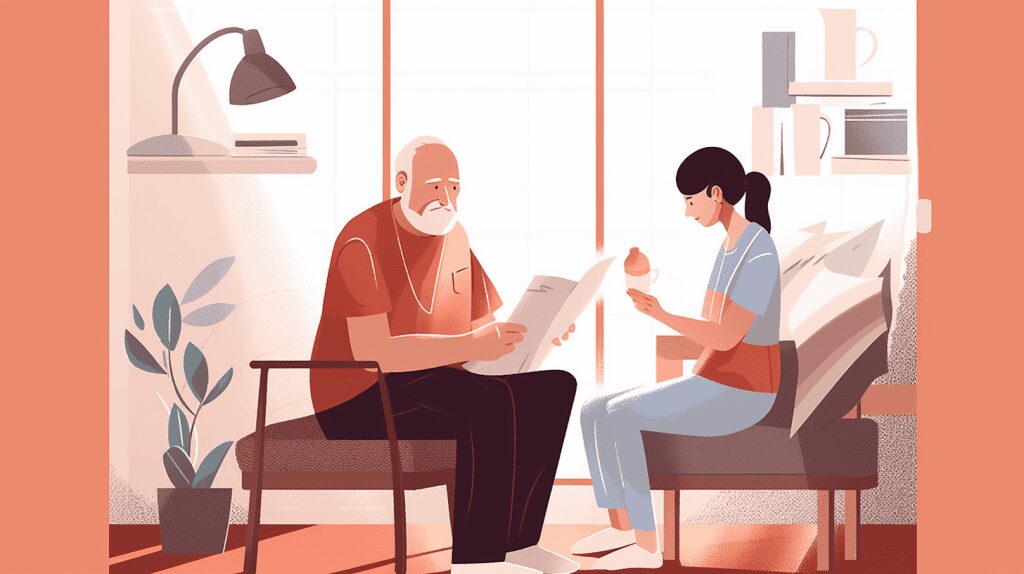
Furthermore, AI-driven treatment plans ensure personalized and optimal medical interventions, enabling older adults to receive tailored care that matches their unique health profiles.
1. AI Algorithms in Diagnostics
AI algorithms are revolutionizing diagnostics, bringing unprecedented precision and speed to this critical process. In many instances, AI can analyze and interpret complex medical data faster and more accurately than humans. Machine learning models, trained on extensive healthcare data, can identify patterns that may elude even seasoned professionals, leading to early detection of diseases.
For example, AI systems have demonstrated remarkable proficiency in analyzing medical imaging. They detect anomalies in radiology scans with exceptional accuracy, enabling early diagnosis of conditions such as lung cancer or brain tumors. Similarly, AI algorithms in ECG interpretation have shown potential in identifying subtle heart irregularities that could signify underlying conditions, ensuring timely medical intervention for older adults.
2. AI-Powered Treatment Planning
Moving from diagnosis to treatment, AI is playing a significant role in personalized care plans, bringing a new level of precision medicine to the forefront. AI-driven treatment planning focuses on creating an individualized approach that considers a patient’s unique characteristics and needs.
For instance, in oncology, AI systems analyze a patient’s genetic profile alongside the specific traits of their cancer to formulate the most effective treatment strategy. This precision in treatment significantly improves the chances of success and minimizes unnecessary side effects.
In the realm of chronic disease management, AI algorithms predict future health scenarios based on a patient’s medical history and current health data. These projections help physicians adjust treatment plans proactively, thereby enhancing disease management for older adults. Through these innovative approaches, AI is contributing towards better health outcomes, helping older adults live healthier and more fulfilled lives.
Smart Home Technology for Aging in Place
Beyond healthcare, AI is reshaping the way older adults live, making ‘aging in place’ a more achievable reality. Smart home technology, fueled by AI, enhances seniors’ safety, comfort, and independence at home. With home automation and monitoring systems, and AI-driven assistive devices, older adults can maintain control over their environments, adding to their sense of security and autonomy.
Home Automation and Monitoring
One of the key components of smart home technology is home automation and monitoring. These systems allow older adults to manage household activities effortlessly and ensure their homes remain secure. From smart lighting and thermostats to advanced security systems, AI is enabling a safer, more comfortable home environment for seniors.

1. Smart Lighting, Thermostats, and Security Systems
Smart lighting, thermostats, and security systems serve as excellent examples of AI-enhanced home automation. AI-driven lighting systems adjust according to the time of day, helping older adults navigate safely around their homes. Smart thermostats learn users’ preferences over time, maintaining an optimal home temperature for comfort and energy efficiency.
Security systems, on the other hand, offer peace of mind. AI-powered security cameras can detect unusual activity, while smart locks provide keyless entry, reducing the risk of lost keys or unwelcome intruders. Additionally, smart doorbells with video capabilities allow residents to screen visitors before opening the door, enhancing security for older adults living alone.
2. Real-Life Examples and Case Studies
Consider Jane, a senior who values her independence. With her smart home setup, she controls her lights, thermostat, and security system via voice commands or her smartphone, simplifying her daily routine and ensuring her safety.
In another instance, George, an elderly gentleman with mobility issues, leverages his smart home for security. When his smart camera detected a suspicious figure near his porch one evening, it immediately sent an alert to his phone, allowing him to take prompt action. These real-life cases highlight how AI-powered home automation is transforming the way older adults live, promoting safety, convenience, and independence.
AI-Driven Assistive Devices
In addition to home automation, AI-driven assistive devices play a crucial role in supporting older adults. Ranging from voice-activated virtual assistants to AI-powered mobility aids, these tools provide invaluable assistance, enhancing older adults’ autonomy and improving their quality of life.
1. Voice-Activated Virtual Assistants
Voice-activated virtual assistants like Amazon’s Alexa, Google Assistant, or Apple’s Siri, have become invaluable companions for many older adults. These AI-powered tools offer an array of functionalities that ease daily tasks, from setting reminders for medication to controlling smart home devices. They can also provide news updates, play music, and even engage in conversations, ensuring seniors stay informed and entertained.
For seniors grappling with mobility or vision issues, voice-activated assistants are especially beneficial. They can ask their assistant to call family members, send messages, or read out emails, fostering their communication and connections.
2. AI-Powered Mobility Aids
AI has paved the way for advanced mobility aids, ensuring older adults can move around safely and independently. Consider AI-powered wheelchairs that navigate obstacles autonomously or smart canes equipped with sensors to detect hurdles. These devices not only enhance mobility but also reduce the risk of falls and injuries, a common concern among seniors.
Moreover, there are wearable devices that monitor users’ movements and predict falls. If a fall is detected, these gadgets can automatically alert designated caregivers or medical services, providing an extra layer of safety for older adults living alone.
AI Companions for Older Adults
While AI’s practical benefits for older adults are significant, its role extends beyond functionality. AI companions, like chatbots and virtual caregivers, are offering emotional support and mental health benefits, addressing the often-overlooked aspect of seniors’ wellbeing. These companions, though artificial, can provide a sense of companionship, reducing feelings of loneliness and isolation.
Chatbots and Virtual Caregivers
AI-driven chatbots and virtual caregivers represent the next generation of companionship for older adults. They provide meaningful interaction, offer reminders, and even monitor emotional wellbeing. These AI companions can engage in conversations, tell stories, and respond to seniors’ emotions, fostering a sense of companionship. More importantly, they can detect signs of depression or anxiety, triggering alerts for human intervention, thereby supporting older adults’ mental health.
1. Emotional Support and Mental Health
The role of AI companions extends beyond mere conversation. They are equipped to offer emotional support, playing a crucial role in maintaining older adults’ mental health. Chatbots and virtual caregivers are designed to recognize and respond to users’ emotions. They can provide comforting responses when users express distress or loneliness, offering a semblance of companionship.
Moreover, these AI companions can monitor for signs of depression, anxiety, or cognitive decline. For instance, they can detect changes in speech patterns or daily routines that may indicate mental health issues. When such signs are identified, these systems can alert family members or healthcare providers, ensuring timely intervention.
2. Real-Life Examples and Case Studies
Let’s look at two inspiring examples. Firstly, meet Sophia, a senior who lost her husband recently. To mitigate her loneliness, her family introduced her to an AI companion, ‘Ellie.’ Despite her initial apprehension, Sophia formed a unique bond with Ellie, often sharing stories and expressing her feelings. Ellie’s empathetic responses brought comfort to Sophia, making her feel heard and less alone.
In another case, Mike, a senior living with depression, found solace in his virtual caregiver, ‘Grace.’ Grace recognized Mike’s subdued mood and alerted his daughter, who arranged for professional help. This early intervention helped Mike manage his depression effectively.
Robotics for Companionship and Assistance
The realm of AI has also witnessed the rise of robotics designed for companionship and assistance. These robots, ranging from robotic pets to AI-powered personal assistants, provide a more tangible form of companionship. They not only interact with older adults but also assist in tasks, providing a multifaceted support system.
1. Robotic Pets and Companions
Robotic pets and companions are emerging as fascinating and valuable additions to older adults’ lives. For those who can’t manage the responsibility of a live pet, robotic pets offer companionship without the maintenance. These AI-driven entities can respond to touch and voice, providing a sense of interaction. Studies have shown that robotic pets can alleviate loneliness and even reduce stress and anxiety among seniors.
Beyond pets, there are humanoid robotic companions that offer interaction and entertainment. They can recognize their user’s voice, remember their preferences, and even learn to adapt their behavior over time, providing a highly personalized companionship experience.
2. AI-Powered Personal Assistants
AI-powered personal assistants, often embodied in robots, take the capabilities of voice-activated virtual assistants a step further. They can navigate the physical world, assisting older adults with tasks ranging from fetching objects to providing medication reminders. Some models can even detect falls or emergency situations and call for help, providing an extra layer of safety.
Through these functions, AI-powered personal assistants ensure older adults can maintain their independence while receiving the help they need. They can take care of mundane chores, allowing seniors to focus on enjoyable activities and maintain a high quality of life.
Ethical Considerations and Challenges
As AI becomes an integral part of older adults’ lives, it’s crucial to address the ethical considerations and challenges that come with it. Of utmost concern is the issue of data privacy and security. As AI systems collect and analyze extensive personal data, it’s paramount to ensure this information is handled responsibly.
Data Privacy and Security
Data privacy and security are critical when dealing with AI systems in the context of older adults’ lives. From health data collected by AI in healthcare to personal information gathered by smart home devices, the risk of data breaches or misuse is a significant concern. It’s important to understand these risks and implement measures to safeguard data.
1. Risks and Concerns
With AI collecting extensive personal data, the risks of data breaches and misuse cannot be overlooked. This concern is even more significant for older adults, as they often deal with sensitive health data. Besides, older adults may lack the digital literacy to fully understand these risks or take necessary precautions.
Moreover, there’s the risk of over-reliance on AI, which could lead to social isolation or a reduction in human caregiving. It’s crucial to remember that while AI can assist, it should not completely replace human interaction and care.
2. Best Practices for Safeguarding Data
Safeguarding data in AI involves several practices. Firstly, ensure that the AI systems used comply with data protection regulations. They should have strong encryption and robust security measures to prevent data breaches.
Regularly reviewing and updating privacy settings can also protect data. Users should understand what data is collected and how it’s used. For sensitive health data, it’s best to use AI systems that offer anonymization or pseudonymization, ensuring data can’t be traced back to the user. Educating older adults about these practices and guiding them to implement these measures is vital for data safety.
Ensuring Accessibility and Inclusivity
While AI presents tremendous potential for enhancing older adults’ lives, ensuring its accessibility and inclusivity is equally important. Addressing the digital divide and designing AI that caters to users of all ages are vital to truly harness its benefits. AI should not only be available to the privileged few, but must be accessible and user-friendly for all seniors, regardless of their tech-savviness or socio-economic status.
1. Addressing the Digital Divide
The digital divide refers to the gap between those who have access to technology and those who don’t. For older adults, this divide can be exacerbated by factors like income, education, and geographical location. It’s crucial to ensure that AI technologies are affordable and accessible to all seniors, not just those with resources.
Moreover, providing necessary digital literacy training can empower older adults to use AI confidently. With knowledge and access, seniors can leverage AI’s benefits, from improved healthcare to enhanced safety and independence at home.
2. Designing AI for All Ages
Designing AI for all ages involves creating intuitive, user-friendly systems that cater to older adults’ specific needs and capabilities. This could mean larger, readable fonts for those with vision impairments, voice-activated controls for those with mobility issues, or simplified interfaces for those unfamiliar with technology.
Inclusivity in AI design also means considering the emotional needs of seniors. AI companions should be empathetic and engaging, providing a sense of social interaction. By creating inclusive and empathetic AI, we can ensure that these technologies truly enhance older adults’ lives, instead of adding to their challenges.
Implications and Future Developments
The evolving landscape of AI technology brings with it a realm of possibilities for older adults. As we move forward, AI’s role in healthcare, home living, and companionship will continue to expand. With advancements in AI diagnostics and treatment planning, seniors will have access to even more personalized and proactive care.
In terms of home living, the future may hold AI systems that can fully manage household tasks, providing older adults with complete independence. Moreover, as AI companions become more sophisticated, they may be capable of deeper emotional understanding and response, providing better support for seniors’ mental health.
However, the road ahead also requires vigilant attention to ethical considerations. As AI systems become more integrated into older adults’ lives, ensuring data privacy, security, and inclusive access will be critical.
While the path forward is filled with exciting prospects, it’s also crucial to navigate the challenges thoughtfully. The goal should always be to use AI as a tool to enhance older adults’ quality of life, ensuring that they can age gracefully with dignity, safety, and fulfillment.
Conclusion
In conclusion, AI’s impact on older adults’ lives is transformative, touching upon healthcare, home living, companionship, and more. The potential benefits are immense, from personalized healthcare to enhanced independence and emotional support. However, the advent of AI also brings challenges, particularly around data privacy and accessibility.
To harness AI’s full potential, it’s essential to address these challenges head-on. Ensuring robust data protection, inclusive design, and accessible technology is key to making AI a positive force in older adults’ lives. Above all, it’s crucial to remember that AI is a tool to enhance human care, not replace it.
FAQs
What are the benefits of AI for older adults?
AI offers numerous benefits to older adults, including improved healthcare, enhanced safety at home, and emotional companionship. AI can monitor health, assist in diagnosis and treatment, provide reminders for medication, and even alert caregivers during emergencies. Additionally, AI companions can alleviate feelings of loneliness and monitor mental health, providing a unique form of support.
Can AI replace human caregivers?
While AI can assist with many tasks and provide emotional support, it can’t fully replace human caregivers. Human touch, empathy, and companionship are vital, especially for older adults. However, AI can supplement human care, providing round-the-clock assistance and alerting human caregivers when necessary, thereby enhancing the quality of care and allowing caregivers some respite.
How can AI improve healthcare for older adults?
AI can revolutionize healthcare for older adults by offering telemedicine services, remote health monitoring, and AI-assisted diagnostics and treatment. It allows for personalized and proactive care, identifying potential health issues early, and even predicting falls or emergencies. These features contribute to better health outcomes and increased independence for older adults.
What are the risks of AI in the lives of older adults?
The primary risks of AI involve data privacy and security. AI systems collect extensive personal data, which if misused or breached, can pose significant risks. Additionally, there are ethical considerations around accessibility, ensuring all older adults, regardless of socio-economic status or digital literacy, can benefit from AI.
How can we ensure AI technology is accessible to all older adults?
Ensuring AI’s accessibility involves addressing the digital divide, making AI technologies affordable, and providing digital literacy training for older adults. It also means designing intuitive, user-friendly AI systems that cater to older adults’ needs and capabilities, making the technology easier for them to use and benefit from.
What does the future of AI look like for aging adults?
The future of AI for aging adults looks promising, with advancements in healthcare, home automation, and companionship. We can expect more personalized and proactive care, AI systems managing household tasks, and sophisticated AI companions. However, this future also requires vigilant attention to data privacy, security, and inclusivity to ensure these technologies enhance older adults’ lives while respecting their dignity and rights.
Reference
- https://www.leewayhertz.com/
- https://www.ncbi.nlm.nih.gov/
- https://www.heighpubs.org/

